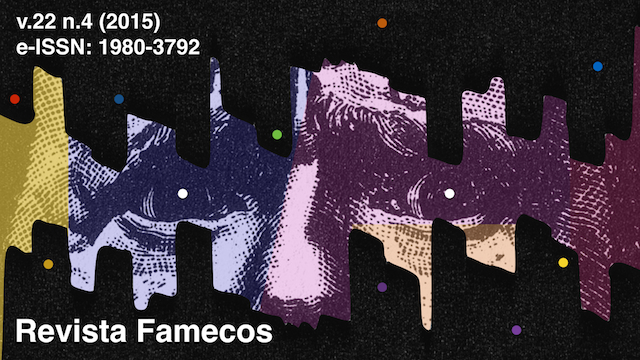Repensando o deslocamento da mídia: as tensões entre as mídias móveis e a interação face-a-face
DOI:
https://doi.org/10.15448/1980-3729.2015.4.21005Palavras-chave:
Phubbing, Deslocamento da mídia, Mídias móveisResumo
O neologismo phubbing, junção de palavras que remetem às atividades mediadas pelo telefone e efeitos de desprezo, fornece imperativos para acentuar a percepção ubíqua de ser aborrecido, ignorado e ofendido em razão de um dispositivo móvel presente em situações de interação pessoal. Seu sintomático registro acompanha importantes descobertas sobre a difusão de mídias móveis em países em desenvolvimento, em cujos jovens são os grupos sociais mais ativos nesse cenário.Incorporando e relacionando a teoria do deslocamento da mídia, focamo-nos na análise de um questionário sobre jovens brasileiros e chineses, identificando como compreendem e lidam com as tensões entre as mídias móveis e a interação face-a-face. Os resultados podem contribuir com novas nuances a discussão sobre deslocamento da mídia.Downloads
Referências
AUTER, P. J. Portable social groups: willingness to communicate, interpersonal communication gratifications, and cell phone use among young adults. International Journal of Mobile Communications, v.5, n. 2, p. 139-156, 2007.
AUXILIADORA DESSEN, M.; TORRES, C. V. Family and socialization factors in Brazil: An overview. Online readings in psychology and culture, v. 6, n. 3, 2002.
BAYM, N. K. Personal connections in the digital age. Polity, 2010.
BIAN, Y. . Bringing strong ties back in: Indirect ties, network bridges, and job searches in China. American sociological review, 1997. p. 366-385.
CAMPBELL, S. W.; RUSSO, T. C. The cocial construction of mobile telephony: an application of the social influence model to perceptions and uses of mobile phones within personal communication networks. Communication Monographs, v. 70, n.
, p. 317-334, 2003.
CNNIC. Research Report on Mobile Internet in China. 2014. Retrieved from: http://www.cnnic.cn/hlwfzyj/hlwxzbg/ydhlwbg/201408/P020140826360212699278.pdf Accessed in: mar. 2015.
DIMMICK, J.; CHEN, Y., & Li, Z. Competition between the Internet and traditional news media: The gratification-opportunities niche dimension. The Journal of Media Economics, v. 17, n. 1, 19-33, 2004.
FUNDAÇÃO TELEFONICA. Juventude Conectada. Agência de Conteúdo. 2014.
GARDNER, H.; DAVIS, K. The App generation: How today's youth navigate identity, intimacy, and imagination in a digital world. Yale University Press, 2013.
GERGEN, K. J. The challenge of absent presence. In: KATZ, J. E.; AAKHUS, M. (Eds.)., Perpetual contact: Mobile communication, private talk, public performance. Cambridge University Press, 2002.
GLOBO. Apaixonados por tecnologia ficam 48h sem celulares em 'praia detox'. 2015. Retrieved from: http://g1.globo.com/fantastico/noticia/2015/05/apaixonados-por-tecnologia-ficam-48h-sem-celulares-em-praia-detox.html. Accessed in: Mar. 2015.
GOLUB, A.; LINGLEY, K. Just Like the Qing Empire Internet Addiction, MMOGs, and Moral Crisis in Contemporary China. Games and Culture, v. 3, n. 1, p. 59-75, 2008.
GOFFMAN, E. Behavior in public places. Simon and Schuster. 2008.
HWANG, Y. Is communication competence still good for interpersonal media?: Mobile phone and instant messenger. Computers in Human Behavior, v. 27, n. 2, p. 924-934, 2011.
LENHART, A.; LING, R.; CAMPBELL, S.; PURCELL, K. Teens and Mobile Phones. Pew Research. 2010. Retrieved from: http://www.pewinternet.org/files/old-media//Files/Reports/2010/PIP-Teens-and-Mobile-2010-with-topline.pdf. Accessed in: Mar, 2015.
ISHII, K. Implications of mobility: The uses of personal communication media in everyday life. Journal of Communication, v. 56, n. 2, p. 346-365, 2006.
KAYANY, J. M.; YELSMA, P.. Displacement effects of online media in the socio-technical contexts of households. Journal of Broadcasting & Electronic Media, v. 44, n. 2, p. 215-229, 2000.
LAZARSFELD, P. F. Radio and the printed page. New York: Dell, Sloan and Pearce, 1940.
_____. BERELSON, B.; GAUDET, H. The People’s Choice. New York: Columbia University Press, 1948.
LING, R. New tech, new ties. Cambridge, MA: Mit Press, 2008.
_____. Children, youth, and mobile communication. Journal of Children and Media, v. 1, n. 1, p. 60-67, 2007.
NEWELL, J.; PILOTTA, J. J.; THOMAS, J. C. Mass media displacement and saturation. The International Journal on Media Management, v. 10, n. 4, p. 131-138, 2008.
PEOPLE.CN. What brings forth more and more “look down clan”? 2013. Retrieved from: http://opinion.people.com.cn/GB/363551/369083/index.html
PETERS, O.; BEN ALLOUCH. Always connected: a longitudinal field study of mobile communication. Telematics and Informatics, v. 22, n. 3, p. 239-256, 2005.
PETRIC, G., PETROVICIC, A.; VEHOVAR, V. Social uses of interpersonal communication technologies in a complex media environment. European Journal of Communication, v. 26, n. 2, p. 116-132, 2011.
PIERCE, T. Social anxiety and technology: Face-to-face communication versus technological communication among teens. Computers in Human Behavior, v. 25, n. 6, p. 1367-1372, 2009.
PRZYBYLSKI, A. K.; WEINSTEIN, N.. Can you connect with me now? How the presence of mobile communication technology influences face-to-face conversation quality. Journal of Social and Personal Relationships, v. 30, n. 3, p. 237-246, 2012.
QIU, J. L.. Working-class network society: Communication technology and the information have-less in urban China. MIT Press, 2009.
REID, D. J.; REID, F. J. Text or talk? Social anxiety, loneliness, and divergent preferences for cell phone use. CyberPsychology & Behavior, v. 10, n. 3, p. 424-435, 2007.
STROVER, S. A Retrospective on Convergence, Moral Panic, and the Internet. In Francis L. F. Lee, Louis Leung, Jack L. Qiu, & Donna S. C. Chu (Eds). Frontiers in new media research. Routledge, 2013. p. 132-154.
STALD, G. Mobile identity: Youth, identity, and mobile communication media. Youth, identity, and digital media, 2008. p. 143-164.
THOMPSON, K.. Moral panics. Routledge, 2013.
TURKLE, S. Alone together: Why we expect more from technology and less from each other. Basic books. 2012.
_____. Always-on/always-on-you: The tethered self. In: KATZ, J. E. (Ed). Handbook of Mobile Communication and Social Change. Cambridge, MA: MIT Press, 2006.
VAN CLEEMPUT. Friendship type, clique formation and the everyday use of communication technologies in a peer group: A social network analysis. Information, Communication & Society, v. 15, n. 8, p. 1258-1277, 2012.
YU, L.; TNG, T. H. Culture and design for mobile phones for China. In: KATZ, J. E. (Ed.). Machines that become us: The social context of personal communication technology. Transaction Publishers, p. 187-198, 2003.
YUAN, E. J. From “perpetual contact” to contextualized mobility: Mobile phones for social relations in chinese society. Journal of International and Intercultural Communication, v. 5, n. 3, p. 208-225, 2012.
Zhang, Q. Family communication patterns and conflict styles in Chinese parent-child relationships. Communication Quarterly, v. 55, n. 1, p. 113-128, 2007.
Downloads
Publicado
Como Citar
Edição
Seção
Licença
Direitos Autorais
A submissão de originais para a Revista Famecos implica na transferência, pelos autores, dos direitos de publicação. Os direitos autorais para os artigos publicados nesta revista são do autor, com direitos da revista sobre a primeira publicação. Os autores somente poderão utilizar os mesmos resultados em outras publicações indicando claramente a Revista Famecos como o meio da publicação original.
Licença Creative Commons
Exceto onde especificado diferentemente, aplicam-se à matéria publicada neste periódico os termos de uma licença Creative Commons Atribuição 4.0 Internacional, que permite o uso irrestrito, a distribuição e a reprodução em qualquer meio desde que a publicação original seja corretamente citada.






